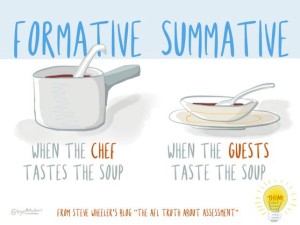(originally posted on Medium)
I’ve heard several metaphors for formative/summative assessment processes, and they are all pretty good: “Formative = check up/Summative=autopsy.” The Edutopia comparison in the graphic above works pretty well too: “Formative=tasting the soup/Summative=eating the soup.” Those metaphors can be useful, but it’s also a bit tricky because neither of them go far enough: the process doesn’t “become” formative until someone USES the information to make a change (e.g. you use information from a check up with your Dr. to change your eating habits, or you add salt to the soup after you taste it). Similarly, the process doesn’t “become” summative until someone forms an evaluative conclusion based on the information (e.g. you figure out that a heart attack killed the patient, or you say that the soup is good but too salty for your taste).
But the soup metaphor can get extended in a different direction too: the way most teachers have to assign grades is to provide an overall, global “mark” (letter, number, etc.) to students over a period of time (quarter, semester, year). That’s a summative process, but a darn tricky one. Eating and evaluating the soup is a summative process, but most of us would probably say “the soup is good — the veggies might be a little big and chunky? And it could use less salt.” That’s a potentially useful, detailed evaluation. But teachers can’t do that. They usually have to give ONE overall mark to student work, which is like boiling down all the complexity and richness of the soup to a thin uniform paste on the bottom of the pan, then evaluating that. Yech.
